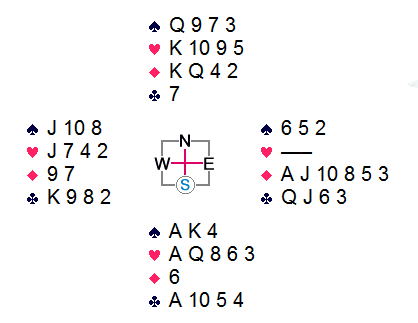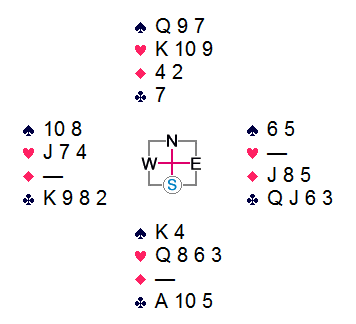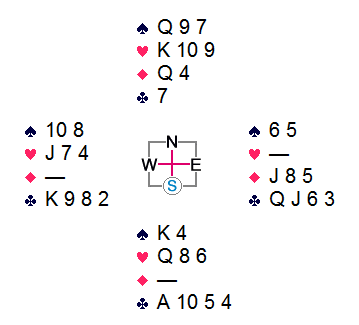

 |
 |
A Sunday Challenge
Many players seem to have a mental block regarding a card combination such
as Kx in hand opposite Axxxx. Needing to cross
to dummy early, declarer generally cashes the king, then leads to the ace.
Similarly, with AKxx opposite a singleton, declarer often
plays off both the ace and king before ruffing the third round of the suit.
These ploys are dangerous, of course, as the second round of the suit might be ruffed in the first example, and the third round might be overruffed in the second. In absence of other potential issues in the hand, the danger can be minimized in both cases by postponing the play of the king until it is safer.
Example #1 is somewhat forgivable. Many players were taught when they
were little babies never to block a suit, so that (generally correct) tendency
is ingrained. Example #2, however, is a flagrant perpetration of the
Pinochle Coup, wherein a player cashes every winner in sight
at the earliest opportunity. Sometimes this is merely a stall for
time — that is, time to come up with an idea. In any case,
the play rarely is correct unless declarer's plan is to "scramble"
the hand, by cashing available winners and then crossruffing.
These considerations relate to today's challenge.

When I showed up for the Tuesday evening game, a couple was spiritedly explaining this deal to another pair. Finding it refreshing when others are sufficiently interested in a hand to write it down and study it, I deemed this one worth sharing:

Taking twelve tricks in hearts is not difficult. Counting winners and exercising a modicum of care are required, however, and only one of seven pairs managed to do both of those things in last Sunday's game.
One solution is to play four rounds of spades immediately, discarding the
diamond from hand. Declarer now can arrange to crossruff seven trump
tricks with the aid of a first-round finesse in hearts. This is
highly double-dummy, however, and no one in his right mind would play
the hand that way.
Let us see what should happen with a club lead. Declarer wins the ace and cashes a high trump, getting the bad news as east signals with the ten of diamonds. Now declarer's singleton diamond goes to the king and ace, and a club is returned, forcing dummy to ruff. Coming to hand with a high spade, declarer finesses in hearts and cashes the heart king. Now another spade to hand enables the run of the remaining trumps, leaving dummy with two winning spades and the high diamond. That wasn't so hard.
Now let's try it against the seemingly more friendly opening lead of the spade jack. As before, a high trump is cashed, then a diamond to the king and ace. This time, however, east returns a diamond. How now?
It is time to count the tricks. one diamond, one club, and four spades with luck, means that six trump tricks will be needed. There are two options: ruff a club in dummy, or ruff two diamonds in hand. Let us say that, on the diamond return, you discard a club and win the queen, leaving this position:

West's echo in diamonds is ominous, and suddenly you realize that, if in fact your left-hand opponent is now out of that suit, it is too late to fulfill your slam. Try ace and a club ruff, spade to the king, heart finesse, heart king. Now, if you could ruff a diamond low in hand, the last trump could be drawn and dummy would be good; but today that doesn't happen. Alternatively, you could plan to ruff a diamond low, then a diamond high. Obviously, that won't work either.
Although I did not observe the play at the successful table, I would like to
think that declarer prevailed by applying the principle discussed in
Example #2: take a diamond ruff when it is safest to do so, leaving this
alternate ending:

A trump finesse is taken, then dummy's low diamond is ruffed with the queen! Another heart finesse enables trumps to be drawn, declarer discarding a club on the last one. The diamond queen, club ace, and three spade tricks take the rest.
This fine dummy-reversal earned a top score on the board.